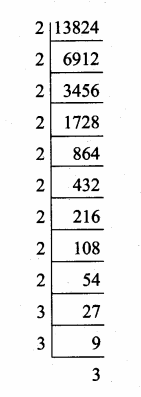பத்தாம் வகுப்பிற்கு கணித பாடத்தில் கற்பிக்கும் ஆசிரியர்களும் மற்றும் மாணவ மாணவியர்களுக்கும் அன்பான வணக்கம்...,
நமது www.kanimaths.com website ஆசிரியர்களுக்கும் மாணவ மாணவியர்களுக்கும் கணித பாடத்தில் பயன்படும் வகையில்
Chapter - 1 : Numbers & sequences EXERCISE : 2.2 அனைத்து கணக்குகளும் தனித்தனியாக தொகுக்கப்பட்டு விடைகளுடன் solved செய்து கீழே கொடுக்கப்பட்டுள்ளது.
ஆசிரியர்களுக்கு பாடம் நடத்தும் வேலையில் ஏதேனும் சந்தேகங்கள் இருந்தால் கீழே கொடுக்கப்பட்டுள்ள கணக்குகளை refer செய்து கொள்ளலாம்.Chapter -1 பயிற்சி கணக்குகள் அனைத்தும் தனித்தனியாக தொகுக்கப்பட்டு கீழே கொடுக்கப்பட்டுள்ளது.
மேலும் மாணவர்களுக்கும் சந்தேகங்கள் இருந்தால் கீழே கொடுக்கப்பட்டுள்ள கணக்குகளை பார்த்து சந்தேகங்களை சரி பார்த்துக் கொள்ளலாம்.
Question 1.
For what values of natural number n, 4th can end with the digit 6?
Answer:
4n = (22)n = 22n
= 2n × 2n
2 is a factor of 4n
∴ 4n is always even.
Question 2.
If m, n are natural numbers, for what values of m, does 2n × 5n ends in 5?
Solution:
2n × 5m
2n is always even for all values of n.
5m is always odd and ends with 5 for all values of m.
But 2n × 5m is always even and ends in 0.
∴ 2n × 5m cannot end with the digit 5 for any values of m. No value of m will satisfy 2n × 5m ends in 5.
Question 3.
Find the H.C.F. of 252525 and 363636.
Answer:
To find the HCF of 252525 and 363636 by using Euclid’s Division algorithm.
363636 = 252525 × 1 + 111111
The remainder 111111 ≠ 0
By division of Euclid’s algorithm
252525 = 111111 × 2 + 30303
The remainder 30303 ≠ 0
Again by division of Euclid’s algorithm
111111 = 30303 × 3 + 20202
The remainder 20202 ≠ 0
Again by division of Euclid’s algorithm.
30303 = 20202 + 10101
The remainder 10101 ≠ 0
Again by division of Euclid’s algorithm.
20202 = 10101 × 2 + 0
The remainder is 0
∴ The H.C.F. is 10101
Question 4.
If 13824 = 2a × 3b then find a and b?
Answer:
Using factor tree method factorise 13824
13824 = 29 × 33
Given 13824 = 2a × 3b
Compare we get a = 9 and b = 3
Aliter:
13824 = 29 × 33
Compare with
13824 = 2a × 3b
The value of a = 9 b = 3
Question 5.
If p1x1 × p2x2 × p3x3 × p4x4 = 113400 where p1 p2, p3, p4 are primes in ascending order and x1, x2, x3, x4, are integers, find the value of p1,p2,p3,p4 and x1,x2,x3,x4.
Answer:
Given 113400 = p1x1 × p2x2 × p3x3 × p4x4
Using tree method factorize 113400
113400 = 23 × 34 × 52 × 7
compare with
113400 = p1x1 × p2x2 × p3x3 × p4x4
P1 = 2, x1 = 3
P2 = 3, x2 = 4
P3 = 5, x3 = 2
P4 = 7, x4 = 1
Question 6.
Find the L.C.M. and H.C.F. of 408 and 170 by applying the fundamental theorem of Arithmetic.
Answer:
Factorise 408 and 170 by factor tree method
408 = 23 × 3 × 17
170 = 2 × 5 × 17
To find L.C.M. list all prime factors of 408 and 170 of their greatest exponents.
L.C.M. = 23 × 3 × 5 × 17
= 2040
To find the H.C.F. list all common factors of 408 and 170.
H.C.F. = 2 × 17 = 34
L.C.M. = 2040 ; HCF = 34
Question 7.
Find the greatest number consisting of 6 digits which is exactly divisible by 24,15,36?
Answer:
The greatest number of 6 digits is 999999.
The greatest number must be divisible by L.C.M. of 24, 15 and 36
15 = 3 × 5
36 = 22 × 32
L.C.M = 23 × 32 × 5
= 360
To find the greatest number 999999 must be subtracted by the remainder when 999999 is divided by 360
The greatest number in 6 digits = 999999 – 279
= 999720
Question 8.
What is the smallest number that when divided by three numbers such as 35, 56 and 91 leaves remainder 7 in each case?
Solution:
35 = 5 × 7
56 = 2 × 2 × 2 × 7
91 = 7 × 13
LCM of 35, 56, 91 = 5 × 7 × 2 × 2 × 2 × 13 = 3640
∴ Required number = 3647 which leaves remainder 7 in each case.
Question 9.
Find the least number that is divisible by the first ten natural numbers?
Answer:
Find the L.C.M of first 10 natural numbers
The least number is 2520
Modular Arithmetic
Two integers “a” and “b” are congruence modulo n if they differ by an integer multiple of n. That b – a = kn for some integer k. This can be written as a = b (mod n).
Euclid’s Division Lemma and Modular Arithmetic
Let m and n be integers, where m is positive. By Euclid’s division Lemma we can write n = mq + r where 0 < r < m and q is an integer.
This n = r (mod m)
பத்தாம் வகுப்பு கணித பாடத்திற்கு அனைத்து பயிற்சி கணக்குகளுக்கும் அனிமேஷன் மூலம் எடுக்கப்பட்டுள்ளது.மேலும் மாணவர்களுக்கு சந்தேகங்கள் இருந்தால் கீழே கொடுக்கப்பட்டுள்ள CLICK HERE என்ற ஆங்கில வார்த்தையை பயன்படுத்தி சந்தேகங்களை சரிபார்த்துக் கொள்ளலாம்.








.jpg)
.jpg)
.jpg)








0 Comments